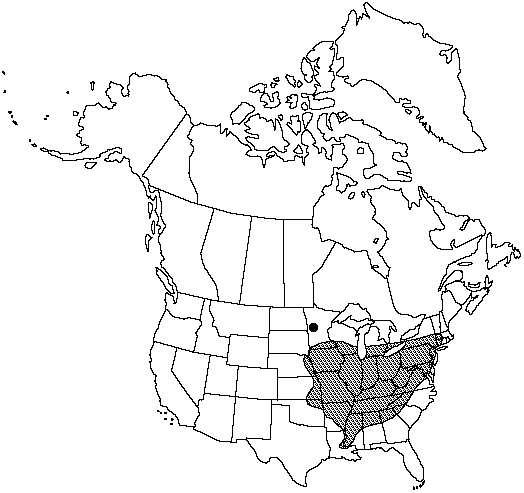Difference between revisions of "Cystopteris protrusa"
Mem. Torrey Bot. Club 21(4): 41. 1963.
FNA>Volume Importer |
FNA>Volume Importer |
||
| Line 20: | Line 20: | ||
}}<!-- | }}<!-- | ||
| − | --><span class="statement" id="st- | + | --><span class="statement" id="st-undefined" data-properties=""><b>Stems </b>creeping, not cordlike, internodes long, 0.5–1 cm, with persistent petiole bases, covered with tan to golden hairs, especially toward apex; scales tan to light brown, ovate-lanceolate to lanceolate, radial walls thin, luminae tan, mostly crowded at stem apex. <b>Leaves</b> seasonally dimorphic, clustered 1 to several cm beyond persistent old petiole bases, especially in late spring and early summer, to 45 cm, bearing sori (earliest leaves smaller, sterile, coarsely divided, margins with rounded teeth; subsequent leaves larger, fertile, more finely divided, margins with sharply pointed teeth). <b>Petiole</b> mostly green to straw-colored throughout, shorter than or nearly equaling blade, base sparsely scaly. <b>Blade</b> ovate to elliptic, 1-pinnate-pinnatifid to 2-pinnate, widest at or just below middle, apex broadly acute; rachis and costae lacking gland-tipped hairs or bulblets; axils of pinnae lacking multicellular, gland-tipped hairs. <b>Pinnae</b> usually perpendicular to rachis, not curving toward blade apex, margins dentate to serrate; proximal pinnae pinnatifid to pinnate-pinnatifid, ± equilateral, basiscopic pinnules not enlarged, basal basiscopic pinnules stalked, base truncate to obtuse; distal pinnae deltate to ovate. <b>Veins</b> mostly directed into teeth. <b>Indusia</b> ovate to cup-shaped, lacking gland-tipped hairs. <b>Spores</b> spiny, usually 28–34 µm. <b>2n</b> = 84.</span><!-- |
-->{{Treatment/Body | -->{{Treatment/Body | ||
| + | |phenology=Sporulating spring–summer. | ||
|habitat=In soil of moist, deciduous forests | |habitat=In soil of moist, deciduous forests | ||
|elevation=0–1500 m | |elevation=0–1500 m | ||
| Line 42: | Line 43: | ||
|basionyms=Cystopteris fragilis var. protrusa | |basionyms=Cystopteris fragilis var. protrusa | ||
|family=Dryopteridaceae | |family=Dryopteridaceae | ||
| + | |phenology=Sporulating spring–summer. | ||
|habitat=In soil of moist, deciduous forests | |habitat=In soil of moist, deciduous forests | ||
|elevation=0–1500 m | |elevation=0–1500 m | ||
| Line 49: | Line 51: | ||
|publication year=1963 | |publication year=1963 | ||
|special status= | |special status= | ||
| − | |source xml=https://jpend@bitbucket.org/aafc-mbb/fna- | + | |source xml=https://jpend@bitbucket.org/aafc-mbb/fna-data-curation.git/src/9216fc802291cd3df363fd52122300479582ede7/coarse_grained_fna_xml/V2/V2_77.xml |
|genus=Cystopteris | |genus=Cystopteris | ||
|species=Cystopteris protrusa | |species=Cystopteris protrusa | ||
| − | |||
| − | |||
| − | |||
| − | |||
| − | |||
| − | |||
| − | |||
| − | |||
| − | |||
| − | |||
| − | |||
| − | |||
| − | |||
| − | |||
| − | |||
| − | |||
| − | |||
| − | |||
| − | |||
| − | |||
| − | |||
| − | |||
| − | |||
| − | |||
| − | |||
| − | |||
| − | |||
| − | |||
| − | |||
| − | |||
| − | |||
| − | |||
| − | |||
| − | |||
| − | |||
| − | |||
| − | |||
| − | |||
| − | |||
| − | |||
| − | |||
| − | |||
| − | |||
| − | |||
| − | |||
| − | |||
| − | |||
}}<!-- | }}<!-- | ||
-->[[Category:Treatment]][[Category:Cystopteris]] | -->[[Category:Treatment]][[Category:Cystopteris]] | ||
Revision as of 14:27, 27 July 2019
Stems creeping, not cordlike, internodes long, 0.5–1 cm, with persistent petiole bases, covered with tan to golden hairs, especially toward apex; scales tan to light brown, ovate-lanceolate to lanceolate, radial walls thin, luminae tan, mostly crowded at stem apex. Leaves seasonally dimorphic, clustered 1 to several cm beyond persistent old petiole bases, especially in late spring and early summer, to 45 cm, bearing sori (earliest leaves smaller, sterile, coarsely divided, margins with rounded teeth; subsequent leaves larger, fertile, more finely divided, margins with sharply pointed teeth). Petiole mostly green to straw-colored throughout, shorter than or nearly equaling blade, base sparsely scaly. Blade ovate to elliptic, 1-pinnate-pinnatifid to 2-pinnate, widest at or just below middle, apex broadly acute; rachis and costae lacking gland-tipped hairs or bulblets; axils of pinnae lacking multicellular, gland-tipped hairs. Pinnae usually perpendicular to rachis, not curving toward blade apex, margins dentate to serrate; proximal pinnae pinnatifid to pinnate-pinnatifid, ± equilateral, basiscopic pinnules not enlarged, basal basiscopic pinnules stalked, base truncate to obtuse; distal pinnae deltate to ovate. Veins mostly directed into teeth. Indusia ovate to cup-shaped, lacking gland-tipped hairs. Spores spiny, usually 28–34 µm. 2n = 84.
Phenology: Sporulating spring–summer.
Habitat: In soil of moist, deciduous forests
Elevation: 0–1500 m
Distribution

Ont., Ala., Ark., Conn., Del., Ga., Ill., Ind., Iowa, Kans., Ky., La., Md., Mass., Mich., Minn., Miss., Mo., Nebr., N.J., N.Y., N.C., Ohio., Okla., Pa., S.C., Tenn., Va., W.Va., Wis.
Discussion
The terrestrial habit and characteristic stem features (golden hairs and protruding apex) readily distinguish Cystopteris protrusa from other Cystopteris species with which it may be sympatric (C. tenuis, C. tennesseensis, and C. bulbifera). Cystopteris tennesseensis and C. tenuis are allotetraploids that have C. protrusa as one parent. The other progenitor for C. tennesseensis is C. bulbifera, and a presumably extinct diploid is proposed here as the progenitor for C. tenuis. When C. protrusa is sympatric with either of these derived tetraploid species, sterile triploids are often produced. In addition, there are sterile autotriploids within C. protrusa (C. H. Haufler et al. 1985).
Selected References
None.